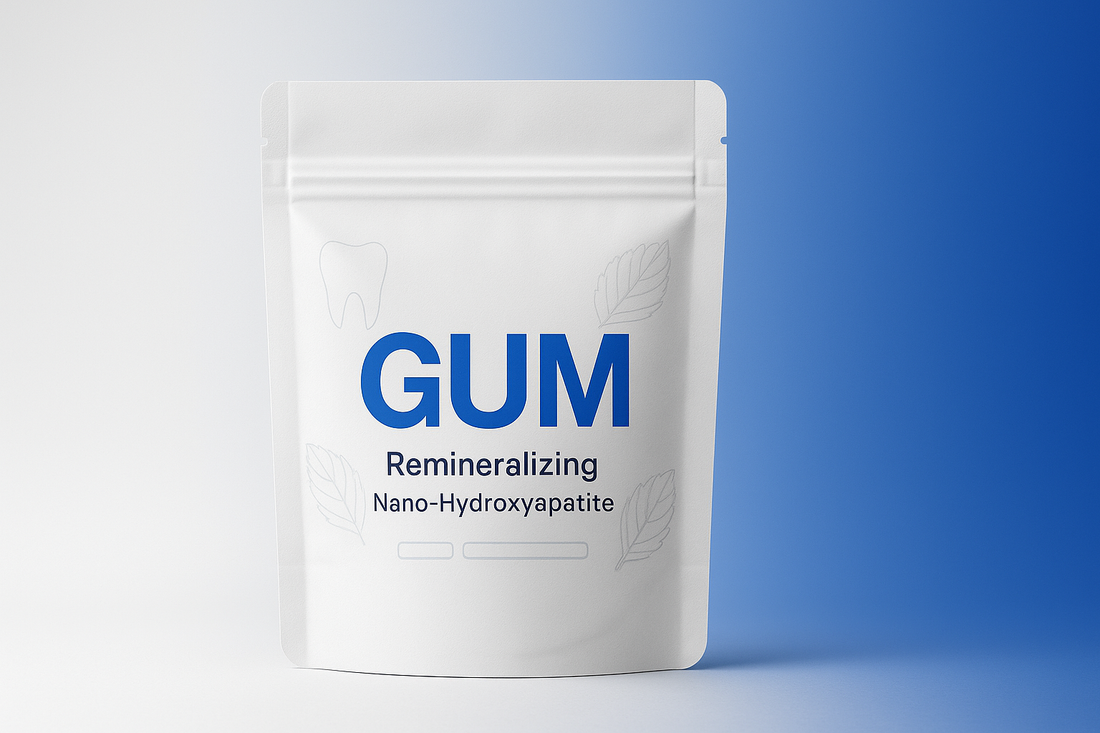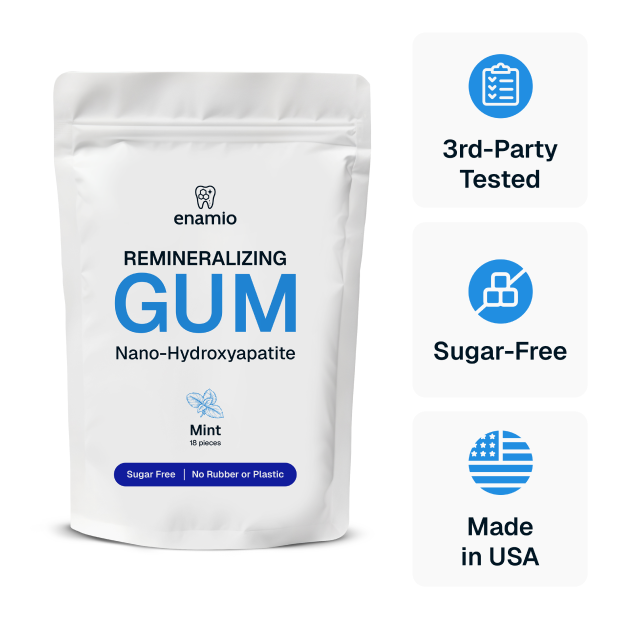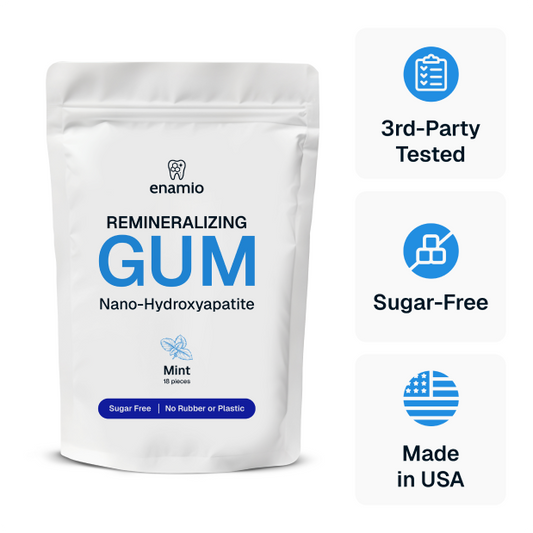
Best Natural Sugar-Free Gum (2025): Science-First Buyer’s Guide | Enamio
Share
Best Natural Sugar-Free Gum (2025): A Science-First Buyer’s Guide
The best natural sugar free gum doesn’t just freshen breath; it works with your saliva, timing, and minerals to actively support enamel day-to-day. Below, we cut through “natural” marketing, explain what plastic-free really means, share peer-reviewed evidence on xylitol, arginine, nano-hydroxyapatite (n-HA), and CaGP, then compare leading brands—plus a buyer’s checklist and usage protocol you can actually follow.

Key takeaways
- Natural ≠ automatically tooth-friendly. Look for a plastic-free base (chicle), non-cariogenic sweeteners (xylitol, monk fruit), and evidence-based actives (n-HA, CaGP, arginine).
- Timing matters. Chewing sugar-free gum for about 20 minutes after meals supports enamel via saliva flow and acid neutralization (ADA guidance).
- Actives amplify benefits. n-HA, CaGP, arginine (ADS), zinc, and catechins each support biofilm ecology, surface hardness, or breath—beyond flavor alone.
- Why Enamio? Plastic-free chicle + highest nano-HA concentration of any gum we’ve seen (no % claims) + CaGP + arginine + zinc + matcha. Designed for classic chew (no crumbling) and science-first performance.
Table of contents Tap to expand
- Why natural sugar-free gum matters
- The science: saliva, pH, and minerals
- Buyer’s criteria (what “best” actually looks like)
- How to read labels (base, sweeteners, actives)
- How Enamio works (and why it stands out)
- How to use: after-meal protocol (step-by-step)
- Comparison: Enamio vs Underbrush, Simply Gum, Glee Gum
- Real-world scenarios & troubleshooting
- People Also Ask (quick answers)
- FAQs
- References
Why “natural sugar-free gum” matters (and what most people miss)
Globally, oral diseases affect roughly 3.5–3.7 billion people, and untreated tooth decay in permanent teeth remains the most common condition in Global Burden of Disease reporting. Choosing the best natural sugar free gum is a small habit with outsized impact: it can help neutralize post-meal acids, support enamel at the surface, and reduce malodor—if the gum’s base and actives are dialed.
The catch: “gum base” on many labels can legally include synthetics like polyvinyl acetate and polyethylene (allowed under 21 CFR 172.615). That’s still sugar-free, but it’s not plastic-free. If you care about ingredients touching your teeth for 20 minutes a pop, a natural chicle base is the benchmark—and combining chicle with proven oral actives turns a breath mint into a micro-oral-care ritual.
The science: saliva, pH buffering, and mineral redeposition
1) Saliva dynamics at the right time
Chewing triggers an immediate surge in salivary flow—peaking in the first minute and remaining above baseline for about 20 minutes. Clinically, the American Dental Association notes that chewing sugar-free gum for 20 minutes after meals can help prevent decay by washing, buffering acids, and delivering protective components in saliva. Translation: if you time your chew right after you eat, you ride the saliva wave when acids would otherwise be softening enamel.
2) Sweeteners that do more than sweeten
Xylitol is not fermentable by plaque bacteria and, in gum form, has repeatedly shown reduced Streptococcus mutans and plaque vs controls in systematic reviews—useful signals, even as broader caries outcomes vary across contexts. Monk fruit (mogroside V) adds clean sweetness without feeding biofilm; it’s GRAS in the U.S. and has favorable EFSA evaluations as a food additive. Together, they deliver taste without undoing the point of sugar-free.
3) Arginine (ADS) = pH resilience
Certain beneficial microbes use the arginine deiminase system (ADS) to convert arginine into ammonia, nudging plaque pH upward and countering acidogenic strains. Studies link higher ADS activity with lower caries experience, and exogenous arginine can enhance ADS activity in plaque. In short: arginine helps your biofilm defend itself from acid swings.
4) Mineral donors: n-HA and CaGP
n-HA (nano-hydroxyapatite) is enamel-identical mineral. Multiple clinical and translational reviews support its role in inhibiting demineralization and improving early lesion metrics in toothpastes/mouthrinses. Delivering n-HA via gum adds timing—saliva flow during the post-meal acid window—while particles adsorb to pellicle and lesion surfaces. CaGP (calcium glycerophosphate) in rinses shows microhardness recovery and synergy with fluoride; as an ion donor in gum, it helps saturate saliva right when you need it.
5) Breath health: zinc + catechins
Volatile sulfur compounds (VSCs) drive malodor. Zinc binds sulfur, reducing VSCs in clinical trials, and green tea catechins (EGCG) show antibacterial effects against S. mutans and biofilm virulence. Pairing low-dose zinc with catechins in gum provides a gentler, stain-free route compared with heavy antiseptics—all while you chew.
Buyer’s criteria: what the best natural sugar-free gum actually looks like
- Base: plastic-free chicle (tree sap), not generic “gum base” that may include PVAc/polyethylene. It should chew like classic gum—no crumbling, no chalk.
- Sweeteners: primary xylitol plus monk fruit (for clean sweetness without fermentability). Avoid sorbitol-heavy formulas if you’re GI-sensitive.
- Actives: n-HA (nano hydroxyapatite), CaGP, arginine (ADS), with breath-supporting zinc and catechins.
- Label transparency: clear ingredient list, origin, testing; ideally US-made.
- Flavor + mouthfeel: natural mint oils/extracts; no plasticky film.
How to read labels (base, sweeteners, actives)
1) Base: chicle vs “gum base”
If the label says “chicle” or “tree sap,” you’re in plastic-free territory. If it only says “gum base,” it may include synthetics like polyvinyl acetate (PVAc), polyethylene, and various resins permitted by 21 CFR 172.615. Plenty of shoppers are fine with that—but if your goal is natural + performance, chicle wins.
2) Sweeteners: xylitol, erythritol, stevia, monk fruit
- Xylitol: strong gum-specific evidence signaling reduced S. mutans and plaque. Titrate intake if you’re new; high bolus doses can cause GI upset in some users.
- Erythritol: very well tolerated; less gum-specific caries data than xylitol.
- Stevia: intense sweetness; often paired with polyols to soften aftertaste.
- Monk fruit (mogroside V): non-fermentable, US GRAS notices and EFSA safety opinions support its use as a sweetener; good for rounding flavor without feeding plaque.
3) Actives: n-HA, CaGP, arginine, zinc, catechins
You rarely see all five in a gum. n-HA supplies enamel-matching particles; CaGP donates ions; arginine supports alkali generation; zinc tames VSCs; catechins modulate biofilm virulence. Together they target post-meal acid stress, surface hardness, and breath.
Ready to try the clear winner?
Enamio Remineralizing Gum — plastic-free chicle base + n-HA, CaGP, arginine, zinc, matcha. Highest nano-HA concentration of any gum we’ve seen (no % claims), tuned for classic chew.
Buy EnamioHow Enamio works (and why it stands out)
- Plastic-free chicle base: zero synthetic rubbers; a purist foundation that feels like “real gum,” not brittle pellets.
- n-HA (~20 nm class): enamel-identical mineral with robust adjacent-format evidence (pastes/rinses) for early lesion support; in gum, n-HA coincides with peak saliva flow to maximize surface contact.
- CaGP: saliva-soluble Ca/PO4 donor that supports microhardness recovery; adds mineral ions right when acids are highest.
- Arginine (ADS): nudges plaque ecology toward alkali generation (ammonia), raising pH after meals.
- Xylitol + monk fruit: clean sweetness without feeding plaque; xylitol signals reductions in S. mutans and plaque mass.
- Zinc + matcha catechins: zinc neutralizes VSCs for breath; catechins modulate biofilm virulence.
Want the deep science? Start here: Nano-hydroxyapatite gum: science overview, Enamio ingredients explained, What gum actually helps remineralize?.
How to use: after-meal protocol (step-by-step)
- After each meal, chew 1 piece for ~20 minutes (ADA guidance).
- Swallow normally; saliva supplies bicarbonate and minerals.
- Target 2–3 sessions/day. For snacks/coffee, add a short 10–15 minute chew.
- New to xylitol? Introduce gradually; higher single boluses can cause GI upset in sensitive users.
For special cases and deeper timing tips, see: Using remineralizing gum (complete guide) and How often to chew for best results.
Comparison: Enamio vs other natural sugar-free gums
The best natural sugar free gum should be plastic-free and deliver more than flavor. Based on public product pages as of 2025:
| Brand | Base / Sweetener | Remineralization Actives | Notes |
|---|---|---|---|
| Enamio | Chicle; xylitol + monk fruit | n-HA (~20 nm class), CaGP, arginine; zinc + matcha | Plastic-free; highest n-HA concentration we’ve seen in gum; US-made |
| Underbrush (Nathan & Sons) | Chicle; xylitol | Lists n-HA on some pages; specifics vary | Plastic-free positioning; outdoorsy branding |
| Simply Gum (Sugar-Free) | Chicle; xylitol | No n-HA/CaGP declared | Minimalist ingredient list; plastic-free |
| Glee Gum (Sugar-Free) | Chicle; xylitol | No n-HA/CaGP declared | Long-standing natural brand |
Always verify latest labels/claims before buying; formulas can change.
- Which gum ingredients actually help remineralize?
- Why Enamio’s n-HA system outperforms toothpaste roles
- Nano-hydroxyapatite gum: science-backed overview
- Ingredients: complete list & benefits
- Does xylitol gum help teeth—or just breath?
- How to use remineralizing gum (complete guide)
- How often should you chew for benefits?
- Can you rebuild tooth enamel? (2025)
Real-world scenarios & troubleshooting
Coffee, citrus, wine
Acids soften enamel temporarily. Rinse with water, wait a few minutes, then chew Enamio for 15–20 minutes to buffer and resupply minerals at the surface. Avoid brushing the softened enamel immediately.
Orthodontics & aligners
Remove aligners to eat. A post-meal chew helps when you can’t brush right away—saliva clears sugars/acids and n-HA/CaGP support surface hardness.
Dry mouth (xerostomia)
Chewing gum has been shown to increase unstimulated salivary flow and improve dryness scores in many studies. Aim for shorter, more frequent chews throughout the day and hydrate well.
GI sensitivity
Xylitol tolerance varies by dose/bolus. Start with 1 piece once daily and work up; spread intake across the day. Never share xylitol products with pets (especially dogs).
People Also Ask
- What makes a gum “natural” and sugar-free?
- Is sugar-free gum good or bad for teeth?
- Which sweetener is best: xylitol, erythritol, or monk fruit?
- Can gum actually help remineralize enamel?
- How often should I chew the best natural sugar-free gum?
- What if I have dry mouth or dental work?
What makes a gum “natural” and sugar-free?
- Base: chicle (tree sap), not PVAc/polyethylene (common in “gum base”).
- Sweeteners: non-cariogenic: xylitol, monk fruit.
- Add-ons: meaningful actives: n-HA, CaGP, arginine; zinc/catechins for breath.
Is sugar-free gum good or bad for teeth?
Generally beneficial when used after meals—stimulates saliva, buffers acids, and can lower caries risk. ADA cites ~20 minutes after meals.
Which sweetener is best: xylitol, erythritol, or monk fruit?
- Xylitol: strongest gum-specific oral evidence; titrate if GI-sensitive.
- Erythritol: highly tolerated; less gum-specific caries data.
- Monk fruit: non-fermentable high-intensity sweetener; balances taste without feeding plaque.
Can gum actually help remineralize enamel?
Gum adds timing + delivery: saliva stimulation during post-meal acid exposure plus mineral donors (n-HA, CaGP). Evidence is strongest in pastes/rinses; gum is an adjunct that complements brushing and dental care.
How often should I chew the best natural sugar-free gum?
- After each meal (~20 minutes).
- 2–3× daily baseline; more frequent short chews for snacks/coffee.
What if I have dry mouth or dental work?
- Dry mouth: Gum can increase resting flow and improve dryness scores; use shorter, frequent chews.
- Dental work: Generally fine unless your clinician advised otherwise.
FAQs
Is Enamio the best natural sugar-free gum for enamel?
Will it fix cavities?
Is xylitol safe?
Can I use Enamio if I’m sensitive?
Make the switch to a research-driven, plastic-free chew
Enamio ties saliva science to mineral delivery. It’s the best natural sugar free gum for shoppers who want more than mint.
Shop Enamio Remineralizing GumReferences
- World Health Organization. Oral health fact sheet (2025).
- American Dental Association. Chewing Gum — MouthHealthy and ADA Oral Health Topics: Chewing Gum (2023).
- Dawes C. Effects of chewing gums/lozenges on salivary flow and pH (1992).
- Nasseripour M. et al. Sugar-free (xylitol) gum and S. mutans reduction (2021); Plaque quantity (2022).
- Cochrane. Xylitol-containing products for preventing dental caries (2015).
- Nascimento MM. Oral arginine metabolism & caries risk (2013); Arginine effect on biofilm communities (2014).
- Hydroxyapatite reviews: Nanohydroxyapatite in dentistry (2023); HAp caries-prevention in toothpaste (2023); Clinical evidence update (2024).
- CaGP evidence: Fluoride + CaGP mouthrinse (2023).
- Green tea catechins (EGCG): Biofilm effects (2021); Virulence reduction (2024).
- Zinc & halitosis: Zinc lactate mouthwash + tongue scraping (2021); Zn/CHX mouthrinse RCT (2017).
- Monk fruit (mogroside V): FDA GRAS notices GRN 784, GRN 706; EFSA opinion (2019).
- Chewing gum & xerostomia: Systematic review (2023).
- Regulatory: 21 CFR 172.615 — Chewing gum base.
- Competitor pages: Simply Gum; Glee Gum; Underbrush (Nathan & Sons).
- GI tolerance: Oku & Nakamura — laxative thresholds (2007); review Mäkinen (2016).
The best natural sugar free gum = plastic-free chicle base + non-cariogenic sweeteners + real actives. Enamio hits all three with n-HA + CaGP + arginine (plus zinc/matcha), delivering saliva-timed mineral support—without plastic. Chew after meals for ~20 minutes and keep brushing/flossing.
Educational only; not medical advice. Always follow your dental professional’s guidance.

